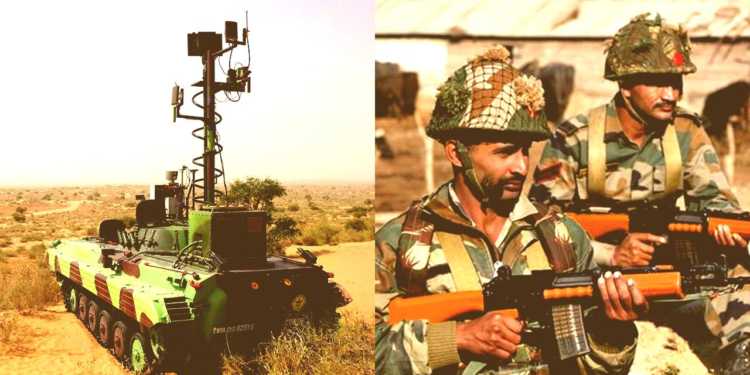One of the most remarkable incidences of the last decade was “when two units of Para SF traversed the so called “Lakshman Rekha” – The line of control on 29th September 2017 and struck the terror launch pads thereby avenging cowardly Uri attack”. If the experts are to be believed, while returning from the mission, one of the commandos stepped on an anti-personnel land mine and was injured. It is said that mines move under the soil during the progression of time and thus locating them is an arduous task.
Source: The History Channel documentary
But here is the good news – The defence Research and Development Organisation (DRDO) has developed a new unmanned tank for surveillance missions, mine detection and scouting in areas with nuclear and bio threats. The tank called Muntra has three variants. While Muntra -S is India’s first tracked ground vehicle developed for unmanned surveillance missions Muntra -M is for detecting mines. Muntra -N is for operation in areas where there is a nuclear radiation or bio weapon risk.
Source : https://en.wikipedia.org/wiki/Munra
With Muntra-M in inventory army will not be required to risk life of soldiers in areas of threat and in modern day warfare the man behind the machine of course matter but machines are getting quite unswerving themselves. With a neighbour that has a suicidal mind-set which can be understood from its “Tactical Nuclear Arsenal”. Hataf IX or Nasr of Pakistan is Solid fuelled tactical nuclear ballistic missile. It has a range of 60-70 KM and Muntra -N is more than a requirement in such a scenario.
Source : https://en.wikipedia.org/wiki/Nasr_(missile)
The future of the combat system is unmanned combat system, and the fresh developments have shown the conjectures are spot-on. Northrop Grumman X-47B, Dassault nEUROn, BAE Systems Taranis or desi Ghatak UCAV are the future of the Arial combat and ground combat is not far behind with the likes of Uran-9, Taifun-M, SUMET and DRDO Daksh. Kentaro Sonoura, Japan’s state minister for foreign affairs and a close adviser to PM Shinzo Abe, told media that there will be more bilateral cooperation between the countries ahead to develop unmanned ground vehicles (UGV) and robotics. “The two PMs agreed to launch a working group, which will work on cooperation between nuclear companies. Japan’s intention is to start this quickly, possibly by the end of this month”. Sonoura said “India and Japan would be setting up a joint task force for commercial agreements by the end of January”. With the legislation backing them, the Japanese minister also added “Tokyo was keen to get this going”.
Doubtless, the relationship between India and Japan has evolved to a level that might have been unthinkable just a few years ago and bears the characteristic authoritative approval of Abe and Modi. PM Modi’s policy diversifying partners and its growing interests in the Indo-Pacific, coupled with an emphasis on act east policy has made New Delhi amenable to closer ties with Tokyo.
The two countries are progressively looking at the world through a similar lens and predominantly with regards to expansionist china. Sonoura added “The next step is infrastructure development based on global standards so that connectivity among countries is increased. The third step would be maritime law enforcement and disaster management that would ensure the stability and prosperity in the Indo-Pacific region. Therefore, we would like to connect and combine our Indo-Pacific strategy and India’s Act East policy as one big picture. That’s the synergy we seek”.
India and Japan both have been bullied by china in past. Thus both Asian colossal economies can deter hostile and modern imperialist China with the mutual cooperation. Japan has smaller forces but they are very advance and well equipped. Deals like amphibious aircraft ShinMaywa US-2 and Soryu class submarine for P75I are in pipeline. Though the cooperation between India and Japan has been minimal in past but with Modi’s Hugplomacy and Abe’s aggressive counter to China, not even sky is the limit.































